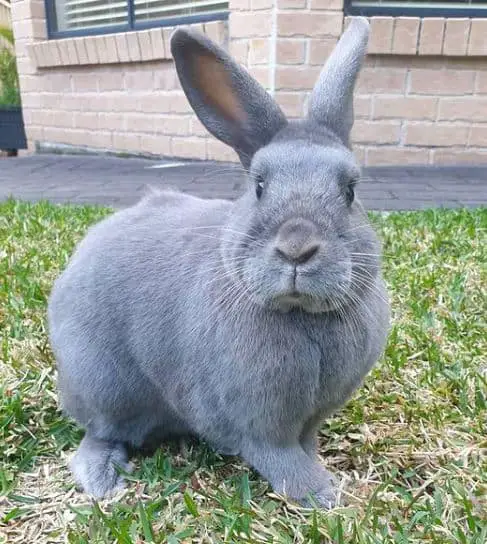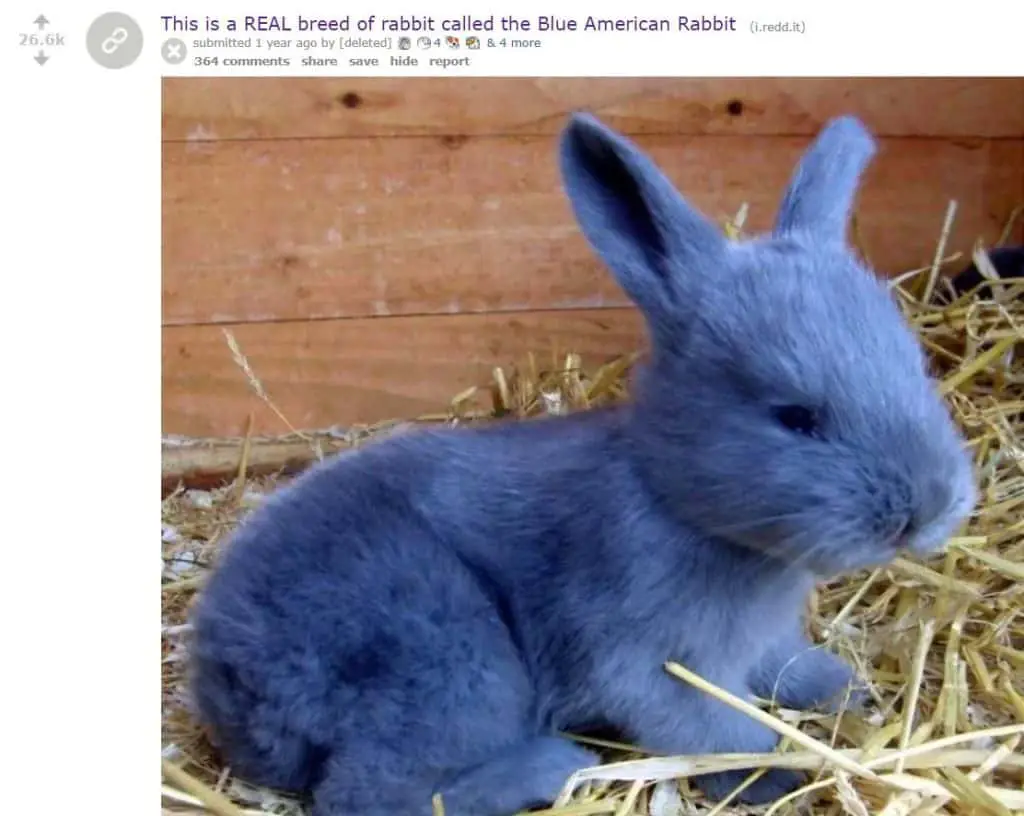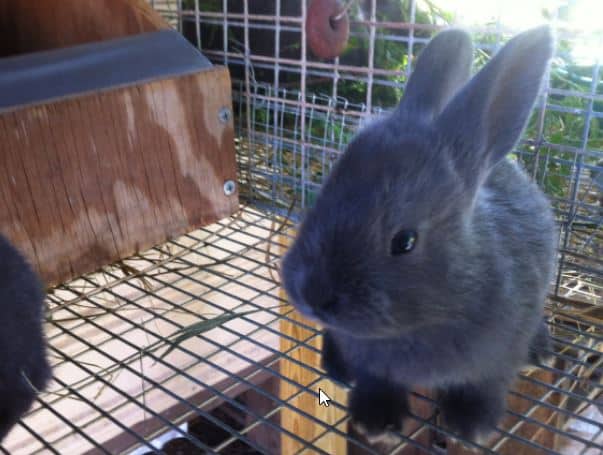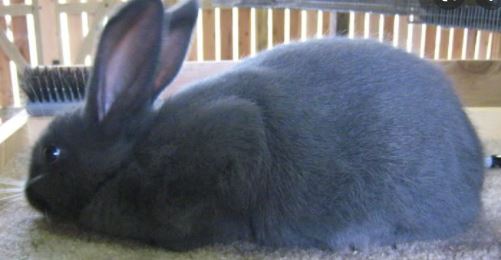While some people claim that blue rabbits are a myth, they are in fact very real! The American Blue Rabbit is a breed that is over 100 years old and was developed by Lewis Salisbury. In order to create the breed, he used several different rabbit breeds such as Blue Flemish Giants, Blue Imperials, Blue Beveren, and Blue Viennas. Some of these breeds are now extinct, but the American Blue is still very much alive.
The American Blue Rabbit, sometimes also simply called American Blue or Blue Rabbit was originally named the “German Blue Vienna”. The name was changed to “American Blue” or simply “American Rabbit” after World War II because many people harbored hostile feelings towards the Germans. The American Rabbit also can also come in white, a result of adding White Flemish Giant blood into the breed.
Fact sheet
| Name(s) | American Blue Rabbit, American Rabbit, Blue Rabbit |
| Species | Oryctolagus cuniculus (European Wild Rabbit) |
| Weight | 9 to 12 pounds |
| Temperament | Docile |
| Experience level needed | Good for novice pet owners |
| Year first recognized by ARBA | 1918 |
| Life expectancy | 8 to 10 years |
Appearance

The American Blue Rabbit’s defining characteristic is its blue fur. Their fur is the bluest of all the rabbit breeds and gives this breed a really unique appearance. This breed is quite large, the average blue rabbit weighs about 9 to 12 pounds with females being slightly heavier than males. They have a long body with a wide, meaty loin. The ears of the blue rabbit are proportional to their narrow head.
The American blue rabbit’s coat is short and is what’s called a “flyback” coat. This means that should you stroke their fur against its natural direction it will go back into its natural position automatically.
Are blue rabbits real?
Yes, blue rabbits are real, but sometimes people are kind of misleading with the pictures they post of this breed. For instance, check out this “blue rabbit” that was posted on Reddit recently:

The post received over 25,000 upvotes with many people believing that blue rabbits actually look like they do in that picture. In reality, you can definitely tell a blue rabbit apart from other breeds by its blue/grayish color but they’re by no means as bright blue as the rabbit in that picture. Their real color is more comparable to that of a Russian Blue Cat.
Are Blue Rabbits rare?
Blue Rabbits used to be listed by Livestockconservancy as “critical”, meaning that the breed was nearing extinction. At that point, according to the book Good Rabbitkeeping by Sue Fox, there were “fewer than 50 annual registrations in the United States and an estimated global population of fewer than 500.” Luckily, this is no longer the case! In the past few years, the breed has grown in popularity which has caused breeders to breed more of them. Currently, Blue Rabbits are listed as “watch” which means that their population has increased substantially from a few years ago.
Nevertheless, it’s still quite a rare breed and if you decide to get a blue rabbit as a pet you’ll be sure to turn some heads with your striking blue rabbit.
Price

Since Blue Rabbits are among the rarest rabbit breeds in the world you might assume that they’re quite pricey. After all, it often happens that breeds that are rare are very expensive. Luckily, with Blue Rabbits this is not the case. You can buy one from rabbitries like SilverCreekRabbitry that have American Blue Rabbits for sale for as little as $25.
The reason why these rabbits are not very expensive even though they’re quite rare is that they are easy to breed.
Temperament
The American Blue is a docile breed with great mothering abilities (one of the reasons why they’re easy to breed!). They’re often affectionate and friendly towards their owners but they’re not a very active breed. Instead, they prefer to spend their time lounging around.
Just like other rabbit breeds, the American Blue Rabbit can be skittish around people if it hasn’t been properly socialized or has not grown up around people. If that’s the case they might bite out of self-defense but they’re generally a calm and loving breed.
Care

Caring for an American Blue Rabbit is not particularly difficult. They’re quite clean animals that groom themselves extensively. Nevertheless, if you notice that your rabbit is dirty do not try to give them a bath. Rabbits are technically capable of swimming but they do not enjoy it so giving them a bath is very stressful for them. Instead, try spot-cleaning the places where they are dirty with a damp towel.
While American Blues groom themselves and do a pretty good job at keeping themselves clean it’s still advised to brush them occasionally, especially when they’re molting and losing a lot of hair.
Many people believe that rabbits are low-maintenance but that’s not the case. While they don’t need to be taken on daily walks like a dog their cage needs to be cleaned at least once a week and you need to offer them fresh food fruits and vegetables every day. Also, you need to spend some time to properly bond with them. The best ways to bond with your rabbit are sitting with them, petting them, giving them treats, or training them.
This breed can be kept inside as well as outside, as long as proper precautions are taken. If you keep them outside make sure that there are no cats or other predators lurking around that can stress them out. Even if the predators can not get into their cage it’s still very stressful for your rabbit to see them from their cage. Furthermore, make sure that they have a large, weatherproof cage with a dedicated space for them to nap and rest.
It’s also recommended to have a fenced-off outdoor space, ideally in your backyard, where your bunnies can go and play on the grass.
Diet
The Blue Rabbit’s diet is similar to that of other rabbit breeds. The majority of their diet should consist of good quality hay and fresh, clean drinking water. Always make sure that your bunny has access to an unlimited supply of fresh water and hay. According to VCAHospitals, rabbits can eat as many leafy green vegetables as they want every day as long as they do not get diarrhea but you should make sure to avoid veggies that are high in carbs such as carrots and potatoes. Good vegetables to feed are romaine lettuce, bok choy, mustard greens, carrot tops, basil, kohlrabi, beet greens, broccoli greens, and cilantro.
Rabbits can also eat fruits in very small amounts as a treat. They should eat no more than 1-2 tablespoons of fresh fruit every 1-2 days.
- How Long Do American Eskimo Dogs Live? Important Factors and Care Tips - September 29, 2023
- Do American Bulldogs Need Grooming? Essential Tips and Care Guidelines - September 29, 2023
- Do Bengal Cats Enjoy Playing? Essential Tips for Keeping Them Active - September 29, 2023